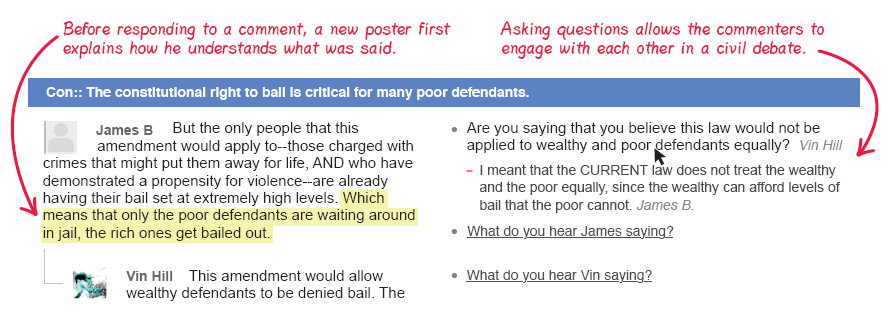Using Mediated Communication Competently
You probably spend a lot of time playing with the various features of a new phone or tablet, but it’s just as important to learn how to communicate competently using technology. Otherwise, you might make some missteps—like sending lengthy text messages when a phone call would’ve been easier or sounding more aggressive than you intended.
Concerned about inflammatory and uncivil discussion in online public forums, computer science researcher Travis Kriplean developed Reflect, a free Web-based program that seeks “better discussion through restatement” (http:/
By trying to minimize conflicts and encourage open discussions online, Kriplean is encouraging competent mediated communication. In addition to your taking the time to really listen to what others are saying, the following suggestions can help you improve your own mediated communication.4 (See Figure 3.2.)
1. Know when to communicate online versus face-to-face. In many situations, online communication is more time efficient than in-person communication. For instance, messaging a friend to remind her of a coffee date makes more sense than dropping by her workplace, and it’s probably quicker and less disruptive than calling her. But online communication is not the best medium for giving in-depth, lengthy, and detailed explanations of professional or personal dilemmas or for conveying weighty relationship decisions. As the chapter’s opening story illustrates, Jack Dorsey places so much value on meeting face-to-face with employees that he doesn’t even have an office.
Since it isn’t practical (or necessary) to deal face-to-face on every issue, there are some guidelines to consider in determining the best medium for your message. First, consider the message itself. Handle emotional messages face-to-face. If this isn’t possible, use synchronous communication (a phone call or video chat) so you can better monitor and respond to the other person’s reactions. With complex and difficult messages, consider using more than one medium. For example, hold a meeting to explain work policy changes and then follow up by e-mailing a summary of your main points or additional details to the meeting attendees. Second, consider the recipient of your message. Does he or she prefer certain means of communication? If so, adapt your format accordingly. For instance, your aunt may not respond to an Evite for a graduation party, but she will open an invitation she receives in the mail.
2. Remember the three Ps. Always remember that mediated communication is powerful, public, and permanent. The things you say and do online endure. Old e-mails, photographs, videos, messages, and blogs—all of these may still be accessible years after you first send them. Think before you post.

3. Practice creating drafts. Because online communication makes it easy to flame, many of us impulsively fire off messages that we later regret. Instead, get into the habit of saving posts, texts, and e-mail messages as drafts. Then revisit the drafts later and edit them as needed for appropriateness, and effectiveness. You may be surprised at how a little time can give you perspective on a message. And don’t forget that sometimes the most competent online communication is none at all. If you are reviewing a draft and realize it’s only going to cause unnecessary damage, delete it.
LearningCurve can help you review! Go to bedfordstmartins.com/
4. Use clear language and provide enough detail. Without feedback, people often misinterpret online messages. To avoid misunderstandings, try to use the clearest words possible. Avoid slang, jargon, and abbreviations unless you know the receiver will understand them and interpret them correctly. This is especially true when giving online presentations or participating in videoconference meetings, when it is important that your audience understand your messages clearly.
In addition, provide enough detail in your messages. In the rush of texting, we often resort to the simplest, shortest messages possible. Take a bit more time to provide enough detail so that the other person has some context for your message. If you text your spouse “home 2 hrs late,” he might wonder if something bad has happened. If your text says, “Still working. Be home 2 hrs late,” he can relax, knowing that you’re OK. For more on how to create understandable messages, see Chapter 5, pages 116–118.
5. Always show respect for others. Empathy deficits can make it hard to communicate in sensitive, respectful ways. So when you’re communicating online, put extra energy into perspective-taking, or seeing things from other people’s point of view, and empathic concern—becoming aware of how other people are feeling and experiencing compassion for them. As Chapter 2 explains (pp. 49–53), this will help you experience and express empathy for other people. This is at the heart of Kriplean’s Reflect program—expressing understanding of and respect for others’ viewpoints. Demonstrating similar kindness, caring, and concern in other forms of mediated communication will go far to reduce tensions, build rapport, and create more positive outcomes in all your communication.
